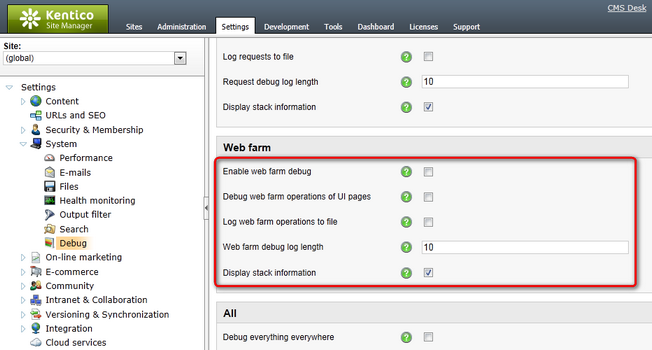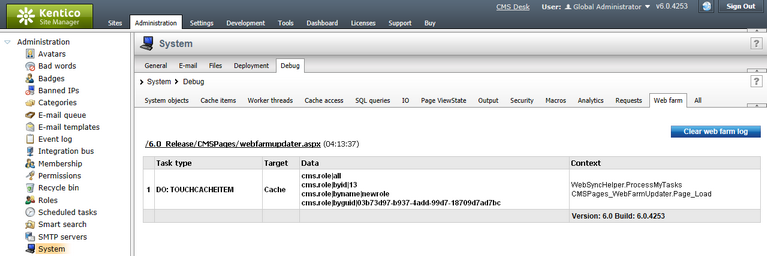Web farm |

|

|

|

|
|
Web farm |

|

|

|

|
|
|
||
Web farm debugging can be turned on and configured either by adjusting certain settings in Site Manager -> Settings -> System -> Debug, or by adding certain keys into the AppSettings section of your web.config file. The following table lists and explains these settings and keys:
Setting |
Web.config key |
Description |
Enable web farm debug |
CMSDebugWebFarm |
Enables request debugging and the Web farm tab in Site Manager -> Administration -> System -> Debug. |
Debug web farm operations of UI pages |
CMSDebugAllWebFarm |
If enabled, operations performed via the administration interface (CMS Desk and Site Manager) will also be included in the web farm debug. This option requires web farm debugging to be enabled. |
Log web farm operations to file |
CMSLogWebFarm |
If enabled, web farm debug log is saved into the logwebfarm.log file in the ~\App_Data folder. This option does not require web farm debugging to be enabled. |
Web farm debug log length |
CMSDebugWebFarmLogLength |
Sets the maximum length of the web farm debug log on the Debug -> Requests tab, i.e. the number of requests for which debug information is preserved and displayed on the tab. If empty, value of the Default log length setting (or the CMSDebugEverythingLogLength key) is used. |
Display stack information |
CMSDebugWebFarmStack |
If enabled, stack is tracked when debugging web farm operations and is displayed in the Context column. This information is only available in the debugging UI and on the live site, not in the debug log written into the logwebfarm.log file. |

Please note that web farm debugging is only functional if web farms are enabled in the web.config and at least one server is defined (as described in Modules -> Web farm synchronization -> Defining web farm server).
It may happen that you specify different configuration in the settings and in the web.config file. In such cases, boolean settings (true/false) need to be enabled at least in one place (in web.config or in settings) in order to be enabled, while log lengths specified in Site Manager -> Settings have higher priority than log lengths specified in the web.config.
Here is a list of the keys for easy copy&paste into your web.config:
<add key="CMSDebugWebFarm" value="true" /> <add key="CMSLogWebFarm" value="true" /> |
Web farm debugging can also be enabled using the general settings and keys.
On the Debug -> Web farm tab, you can see which web farm synchronization tasks were logged and which servers were notified about the changes. This is particularly useful if you want to find out if the web farm works effectively and synchronizes data correctly, or generally if you want to troubleshoot web-farm-related issues.
The following screenshot shows how the debug looks on the source server (the server where the data was modified). The bottom part displays the logged tasks, while the top part shows asynchronous notifications for other web farm servers.

The second screenshot shows how the debug looks on the target server after it is notified about the modification. You can recognize the task by the DO: prefix, which indicates that the synchronization task was (is being) processed.
Enabling the Show complete context check-box displays complete context (not only the topmost item) in the Context column. The log can be cleared using the Clear web farm log button.
